Impact and Classification of Augmented Reality in Science Experiments in Teaching—A Review
Abstract
:1. Introduction
2. Theoretical Background
2.1. Potential of Augmented Reality in Experiments in Science Education
2.2. Defining Augmented Reality
2.3. Design Parameters to AR-Learning Environments
2.3.1. Adaptivity
2.3.2. Interactivity
2.3.3. Immersion
2.3.4. Congruence with Reality
2.3.5. Content Proximity to Reality
2.3.6. Game Elements
2.3.7. Complexity
3. Methodology
3.1. Selection of the Papers
3.2. Criteria Screening
3.3. Extraction of Study Content
4. Results
4.1. RQ1: Which Experiments in Science Education Become Enhanced through AR? How Does AR Become Implemented in Experiments in Science Education?
4.2. RQ2: How Does the Empirical Research Examine the AR Enhanced Laboratories in an Educational Context?
4.3. RQ3: How Are the Designated Design Parameters for AR in Educational Experiments Implemented?
5. Discussion
5.1. RQ1 AR-Enhanced Science Experiments and Implementation Approaches
5.2. RQ2 Empirical Evaluations of AR-Enhanced Laboratory Environments
5.3. RQ3 Implementation of Design Parameters for AR in Educational Experiments
6. Limitations
7. Conclusions
Supplementary Materials
Author Contributions
Funding
Data Availability Statement
Conflicts of Interest
References
- An, J.; Poly, L.-P.; Holme, T.A. Usability Testing and the Development of an Augmented Reality Application for Laboratory Learning. J. Chem. Educ. 2020, 97, 97–105. [Google Scholar] [CrossRef]
- Bates, G.C. The Role of the Laboratory in Secondary School Science Programs. In What Research Says to the Science Teacher; Rowe, M.B., Ed.; National Institute of Education (DHEW): Washington, DC, USA, 1978; Volume I, pp. 55–82. [Google Scholar]
- Hofstein, A.; Lunetta, V.N. The Role of the Laboratory in Science Teaching: Neglected Aspects of Research. Rev. Educ. Res. 1982, 52, 201–217. [Google Scholar] [CrossRef]
- Hofstein, A.; Lunetta, V.N. The Laboratory in Science Education: Foundations for the Twenty-First Century. Sci. Educ. 2004, 88, 28–54. [Google Scholar] [CrossRef]
- Hawkes, S.J. Chemistry Is Not a Laboratory Science. J. Chem. Educ. 2004, 81, 1257. [Google Scholar] [CrossRef]
- Carnduff, J.; Reid, N. Enhancing Undergraduate Chemistry Laboratories; Royal Society of Chemistry: London, UK, 2003; ISBN 978-0-85404-378-1. [Google Scholar]
- Johnstone, A.H. Teaching of Chemistry- Logical or Psychological? Chem. Educ. Res. Pract. 2000, 1, 9–15. [Google Scholar] [CrossRef]
- Toczkowski, T.; Ralle, B. The Complexity of “Simple” Experiment Learning and Understanding in Chemistry Class [Die Komplexität “einfacher” Experimente-Lernen Und Verstehen Im Chemieunterricht]. In Authentizität und Lernen—Das Fach in der Fachdidaktik. Gesellschaft für Didaktik der Chemie und Physik Jahrestagung in Berlin 2015; Maurer, C., Ed.; Universität Regensburg: Regensburg, Germany, 2015; pp. 68–70. [Google Scholar]
- Sorby, S.A. Educational Research in Developing 3-D Spatial Skills for Engineering Students. Int. J. Sci. Educ. 2009, 31, 459–480. [Google Scholar] [CrossRef]
- Kuhn, J.; Müller, A. Context-Based Science Education by Newspaper Story Problems: A Study on Motivation and Learning Effects. Perspect. Sci. 2014, 2, 5–21. [Google Scholar] [CrossRef]
- Probst, C. How Digitalisation Enriches Self-Regulation, Self-Efficacy Expectations, and Motivation in Chemistry Education—A Review. Chem. Sch. 2021, 36, 18–22. (In German) [Google Scholar]
- Cai, S.; Chiang, F.-K.; Sun, Y.; Lin, C.; Lee, J.J. Applications of Augmented Reality-Based Natural Interactive Learning in Magnetic Field Instruction. Interact. Learn. Environ. 2017, 25, 778–791. [Google Scholar] [CrossRef]
- Cai, S.; Liu, C.; Wang, T.; Liu, E.; Liang, J.-C. Effects of Learning Physics Using Augmented Reality on Students’ Self-Efficacy and Conceptions of Learning. Br. J. Educ. Technol. 2021, 52, 235–251. [Google Scholar] [CrossRef]
- Radu, I.; Schneider, B.; Machinery, A.C. What Can We Learn from Augmented Reality (AR)? Benefits and Drawbacks of AR for Inquiry-Based Learning of Physics. In Proceedings of the 2019 CHI Conference on Human Factors in Computing Systems, Glasgow, Scotland, 4–9 May 2019. [Google Scholar]
- Huwer, J.; Barth, C.; Siol, A.; Eilks, I. Combining reflections on education for sustainability and digitalization—Learning with and about the sustainable use of tablets along an augmented reality learning environment (in German). CHEMKON 2021, 28, 235–240. [Google Scholar] [CrossRef]
- Ovens, M.; Ellyard, M.; Hawkins, J.; Spagnoli, D. Developing an Augmented Reality Application in an Undergraduate DNA Precipitation Experiment to Link Macroscopic and Submicroscopic Levels of Chemistry. J. Chem. Educ. 2020, 97, 3882–3886. [Google Scholar] [CrossRef]
- Altmeyer, K.; Kapp, S.; Thees, M.; Malone, S.; Kuhn, J.; Bruenken, R. The Use of Augmented Reality to Foster Conceptual Knowledge Acquisition in STEM Laboratory Courses-Theoretical Background and Empirical Results. Br. J. Educ. Technol. 2020, 51, 611–628. [Google Scholar] [CrossRef]
- Huwer, J.; Lauer, L.; Seibert, J.; Thyssen, C.; Dörrenbächer-Ulrich, L.; Perels, F. Re-Experiencing Chemistry with Augmented Reality: New Possibilities for Individual Support. World J. Chem. Educ. 2018, 6, 212–217. [Google Scholar] [CrossRef]
- Liu, Q.; Yu, S.; Chen, W.; Wang, Q.; Xu, S. The Effects of an Augmented Reality Based Magnetic Experimental Tool on Students’ Knowledge Improvement and Cognitive Load. J. Comput. Assist. Learn. 2021, 37, 645–656. [Google Scholar] [CrossRef]
- Aji, S.D.; Setyowati, T.; Jumina, S.; Hudha, M.N. Augmented Reality: Physics on Wave and Vibration. J. Phys. 2021, 1869, 012090. [Google Scholar] [CrossRef]
- Akçayır, M.; Akçayır, G. Advantages and Challenges Associated with Augmented Reality for Education: A Systematic Review of the Literature. Educ. Res. Rev. 2017, 20, 1–11. [Google Scholar] [CrossRef]
- Albuquerque, G.; Sonntag, D.; Bodensiek, O.; Behlen, M.; Wendorff, N.; Magnor, M. A Framework for Data-Driven Augmented Reality. In Augmented Reality, Virtual Reality, and Computer Graphics: 6th International Conference, AVR 2019, Santa Maria al Bagno, Italy, 24–27 June 2019; Springer: Berlin/Heidelberg, Germany, 2019; Volume 11614, ISBN 0302-9743. [Google Scholar]
- Cai, S.; Chiang, F.-K.; Wang, X. Using the Augmented Reality 3D Technique for a Convex Imaging Experiment in a Physics Course. Int. J. Eng. Educ. 2013, 29, 856–865. [Google Scholar]
- Osman, S. The Effect of Augmented Reality Application toward Student’s Learning Performance in PC Assembly. IJATCSE 2020, 9, 401–407. [Google Scholar] [CrossRef]
- Salmi, H.; Thuneberg, H.; Vainikainen, M.-P. Making the Invisible Observable by Augmented Reality in Informal Science Education Context. Int. J. Sci. Educ. Part B 2017, 7, 253–268. [Google Scholar] [CrossRef]
- Mazzuco, A.; Krassmann, A.L.; Reategui, E.; Gomes, R.S. A Systematic Review of Augmented Reality in Chemistry Education. Rev. Educ. 2022, 10, e3325. [Google Scholar] [CrossRef]
- Page, M.J.; Moher, D.; Bossuyt, P.M.; Boutron, I.; Hoffmann, T.C.; Mulrow, C.D.; Shamseer, L.; Tetzlaff, J.M.; Akl, E.A.; Brennan, S.E.; et al. PRISMA 2020 Explanation and Elaboration: Updated Guidance and Exemplars for Reporting Systematic Reviews. BMJ 2021, 372, n160. [Google Scholar] [CrossRef] [PubMed]
- Shah, I. Making University Laboratory Work in Chemistry More Effective. Ph.D. Thesis, University of Glasgow, Glasgow, Scotland, 2004. [Google Scholar]
- Acosta, J.L.B.; Navarro, S.M.B.; Gesa, R.F.; Kinshuk, K. Framework for Designing Motivational Augmented Reality Applications in Vocational Education and Training. Australas. J. Educ. Technol. 2019, 35, 102–117. [Google Scholar] [CrossRef]
- Reid, N.; Shah, I. The Role of Laboratory Work in University Chemistry. Chem. Educ. Res. Pract. 2007, 8, 172–185. [Google Scholar] [CrossRef]
- Wojciechowski, R.; Cellary, W. Evaluation of Learners’ Attitude toward Learning in ARIES Augmented Reality Environments. Comput. Educ. 2013, 68, 570–585. [Google Scholar] [CrossRef]
- Fatemah, A.; Rasool, S.; Habib, U. Interactive 3D Visualization of Chemical Structure Diagrams Embedded in Text to Aid Spatial Learning Process of Students. J. Chem. Educ. 2020, 97, 992–1000. [Google Scholar] [CrossRef]
- Núñez, M.; Quirós, R.; Núñez, I.; Carda, J.B.; Camahort, E. Collaborative Augmented Reality for Inorganic Chemistry Education. In Proceedings of the 5th WSEAS/IASME International Conference on Engineering Education, Heraklion, Greece, 22–24 July 2008; World Scientific and Engineering Academy and Society (WSEAS): Stevens Point, WI, USA, 2008; pp. 271–277. [Google Scholar]
- An, J.; Holme, T.A. Evaluation of Augmented Reality Application Usage and Measuring Students’ Attitudes toward Instrumentation. J. Chem. Educ. 2021, 98, 1458–1464. [Google Scholar] [CrossRef]
- Gan, H.S.; Tee, N.Y.K.; Mamtaz, M.R.B.; Xiao, K.; Cheong, B.H.-P.; Liew, O.W.; Ng, T.W. Augmented Reality Experimentation on Oxygen Gas Generation from Hydrogen Peroxide and Bleach Reaction. Biochem. Mol. Biol. Educ. 2018, 46, 245–252. [Google Scholar] [CrossRef]
- Hanafi, A.; Elaachak, L.; Bouhorma, M.; Bennis, E.K. Safe Laboratory Practices & Procedures Introduced to the Students Through an Augmented Reality Application. In Proceedings of the 4th International Conference on Smart City Applications, Casablanca, Morocco, 2–4 October 2019. [Google Scholar]
- Sokan, A.; Inagawa, N.; Nishijo, K.; Shinagawa, N.; Egi, H.; Fujinami, K. Alerting Accidents with Ambiguity: A Tangible Tabletop Application for Safe and Independent Chemistry Experiments. In Ubiquitous Intelligence and Computing, Proceedins of the 7th International Conference, UIC 2010, Xi’an, China, 26–29 October 2010; Springer: Berlin/Heidelberg, Germany, 2010; Volume 6406, ISBN 0302-9743. [Google Scholar]
- Sokan, A.; Hou, M.W.; Shinagawa, N.; Egi, H.; Fujinami, K. A Tangible Experiment Support System with Presentation Ambiguity for Safe and Independent Chemistry Experiments. J. Ambient Intell. Humaniz. Comput. 2012, 3, 125–139. [Google Scholar] [CrossRef]
- Tee, N.Y.K.; Gan, H.S.; Li, J.; Cheong, B.H.-P.; Tan, H.Y.; Liew, O.W.; Ng, T.W. Developing and Demonstrating an Augmented Reality Colorimetric Titration Tool. J. Chem. Educ. 2018, 95, 393–399. [Google Scholar] [CrossRef]
- Ajit, G.; Lucas, T.; Kanyan, R. A Systematic Review of Augmented Reality in STEM Education. Stud. Appl. Econ. 2021, 39. [Google Scholar] [CrossRef]
- Milgram, P.; Takemura, H.; Utsumi, A.; Kishino, F. Augmented Reality: A Class of Displays on the Reality-Virtuality Continuum. In Proceedings of the Telemanipulator and Telepresence Technologies, Philadelphia, PA, USA, 25–26 October 1995; Society of Photo-Optical Instrumentation Engineers (SPIE): Bellingham, WA, USA, 1995; Volume 2351, pp. 282–292. [Google Scholar]
- Azuma, R.T. A Survey of Augmented Reality. Presence Teleoperators Virtual Environ. 1997, 6, 355–385. [Google Scholar] [CrossRef]
- Krug, M.; Czok, V.; Müller, S.; Weitzel, H.; Huwer, J.; Kruse, S.; Müller, W. AR in Science Education—An AR Based Teaching-learning Scenario in the Field of Teacher Education. CHEMKON 2022, 29, 312–318. [Google Scholar] [CrossRef]
- Krug, M.; Czok, V.; Huwer, J.; Weitzel, H.; Müller, W. Challenges for the Design of Augmented Reality Applications for Science Teacher Education. In Proceedings of the 15th International Technology, Education and Development Conference, Online, 8–9 March 2021; pp. 2484–2491. [Google Scholar] [CrossRef]
- Paramythis, A.; Loidl-Reisinger, S. Adaptive Learning Environments and E-Learning Standards. Electron. J. E-Learn. 2004, 2, 181–194. [Google Scholar]
- Söldner, G. Semantic Adaptation of Components (in German). Ph.D. Thesis, Friedrich-Alexander-Universität Erlangen-Nürnberg, Erlangen, Germany, 2012. Available online: https://open.fau.de/items/91d9e981-3539-4258-a7a7-53589a675e07 (accessed on 1 May 2024).
- Schulmeister, R. Taxonomy of Interactivity in Multimedia—A Contribution to the Acutal Metadata Discussion (in German). Inf. Technol. 2002, 44, 193–199. [Google Scholar] [CrossRef]
- Slater, M.; Wilber, S. A Framework for Immersive Virtual Environments (FIVE): Speculations on the Role of Presence in Virtual Environments. Presence Teleoperators Virtual Environ. 1997, 6, 603–616. [Google Scholar] [CrossRef]
- McMahan, A. Immersion, Engagement, and Presence—A Method for Analyzing 3-D Video Games. In The Video Game, Theory Reader; Wolf, M.J., Perron, B., Eds.; Routledge: New York, NY, USA, 2013; pp. 67–87. ISBN 10: 0415965799. [Google Scholar]
- Nah, F.F.-H.; Zeng, Q.; Telaprolu, V.R.; Ayyappa, A.P.; Eschenbrenner, B. Gamification of Education: A Review of Literature. HCI Bus. 2014, 8527, 401–409. [Google Scholar]
- Walpuski, M.; Kauertz, A.; Fischer, H.; Kampa, N.; Mayer, J.; Sumfleth, E.; Wellnitz, N. ESNaS-Evaluation of the Standards for Science in Lower Secondary Education. In Bildungsstandards Und Kompetenzmodelle: Beiträge Zu Einer Aktuellen Diskussion Über Schule, Lehrerbildung Und Unterricht; Gehrmann, A., Hericks, U., Lüders, M., Eds.; Klinkhardt: Bad Heilbrunn, Germany, 2010. (In German) [Google Scholar]
- Harzing, A.W. Software: Publish or Perish 2007 (Version 23.4.0). Available online: https://harzing.com/ (accessed on 1 May 2024).
- Martinez, G.d.l.C.; Bocanegra, J.R.R.; Cervantes, A.L.E.; Zamorano, C.R.M.A. Exploring “Experimentelly” the pH Value of Products Using Augmented Reality with Tangible Objects. In Proceedings of the Edulearn18: 10th International Conference on Education and New Learning Technologies, Palma, Spain, 2–4 July 2018; ISBN 2340-1117. [Google Scholar]
- Garzón, J.; Kinshuk; Baldiris, S.; Gutiérrez, J.; Pavón, J. How Do Pedagogical Approaches Affect the Impact of Augmented Reality on Education? A Meta-Analysis and Research Synthesis. Educ. Res. Rev. 2020, 31, 100334. [Google Scholar] [CrossRef]
- Sırakaya, M.; Sırakaya, D.A. Augmented Reality in STEM Education: A Systematic Review. Interact. Learn. Environ. 2020, 30, 1556–1569. [Google Scholar] [CrossRef]
- Ewais, A.; Troyer, O.D. A Usability and Acceptance Evaluation of the Use of Augmented Reality for Learning Atoms and Molecules Reaction by Primary School Female Students in Palestine. J. Educ. Comput. Res. 2019, 57, 1643–1670. [Google Scholar] [CrossRef]
- Akcayir, M.; Akcayir, G.; Pektas, H.M.; Ocak, M.A. Augmented Reality in Science Laboratories: The Effects of Augmented Reality on University Students’ Laboratory Skills and Attitudes toward Science Laboratories. Comput. Hum. Behav. 2016, 57, 334–342. [Google Scholar] [CrossRef]
- Kapp, S.; Thees, M.; Beil, F.; Weatherby, T.; Burde, J.-P.; Wilhelm, T.; Kuhn, J. The Effects of Augmented Reality: A Comparative Study in an Undergraduate Physics Laboratory Course. In Proceedings of the 12th International Conference on Computer Supported Education, Prague, Czech Republic, 2–4 May 2020; SCITEPRESS—Science and Technology Publications: Prague, Czech Republic, 2020; pp. 197–206. [Google Scholar]
- Kapp, S.; Thees, M.; Beil, F.; Weatherby, T.; Burde, J.-P.; Wilhelm, T.; Kuhn, J. Using Augmented Reality in an Inquiry-Based Physics Laboratory Course. In Proceedings of the Computer Supported Education; Lane, H.C., Zvacek, S., Uhomoibhi, J., Eds.; Springer International Publishing: Cham, Switzerland, 2021; pp. 177–198. [Google Scholar]
- Kapp, S.; Lauer, F.; Beil, F.; Rheinländer, C.C.; Wehn, N.; Kuhn, J. Smart Sensors for Augmented Electrical Experiments. Sensors 2022, 22, 256. [Google Scholar] [CrossRef] [PubMed]
- Thees, M.; Altmeyer, K.; Kapp, S.; Rexigel, E.; Beil, F.; Klein, P.; Malone, S.; Brünken, R.; Kuhn, J. Augmented Reality for Presenting Real-Time Data During Students’ Laboratory Work: Comparing a Head-Mounted Display With a Separate Display. Front. Psychol. 2022, 13, 804742. [Google Scholar] [CrossRef] [PubMed]
- Amiraslanov, O.; Javaheri, H.; Bian, S.; Lukowicz, P. Preparation for Future Learning: Augmented-Reality Enhanced Interactive Science Labs. In Proceedings of the 2018 ACM International Joint Conference and 2018 International Symposium on Pervasive and Ubiquitous Computing and Wearable Computers, Singapore, 8–12 October 2018. [Google Scholar]
- Bakri, F.; Pratiwi, S.; Muliyati, D. Video-Enriched Worksheet Based on Augmented Reality Technology: The Heat Experiment Is Easier. In Proceedings of the 8th National Physics Seminar 2019, Jakarta, Indonesia, 29–30 June 2019; ISBN 0094-243X. [Google Scholar]
- Caputo, E.; Lo Moriello, R.S.; De Pandi, F.; Liccardo, A.; Gallicchio, V.; Quarto, M. Exploiting Augmented Reality and Internet of Things for Gamma Ray Experiments in Educational Field. In Proceedings of the 2021 IEEE International Instrumentation and Measurement Technology Conference (I2MTC), Glasgow, UK, 17–20 May 2021; IEEE: Glasgow, UK, 2021; pp. 1–6. [Google Scholar]
- Lo Schiano Moriello, R.; Liccardo, A.; Bonavolonta, F.; Caputo, E.; Gloria, A.; Alteriis, G. On the Suitability of Augmented Reality for Safe Experiments on Radioactive Materials in Physics Educational Applications. IEEE Access 2022, 10, 54185–54196. [Google Scholar] [CrossRef]
- Chen, M.; Li, Y.; Shrestha, H.; Rakotondravony, N.; Teixeira, A.; Harrison, L.; Dempski, R.E. FlowAR: A Mixed Reality Program to Introduce Continuous Flow Concepts. J. Chem. Educ. 2024, 101, 1865–1874. [Google Scholar] [CrossRef]
- Giancaspro, J.W.; Arboleda, D.; Kim, N.J.; Chin, S.J.; Britton, J.C.; Secada, W.G. An Active Learning Approach to Teach Distributed Forces Using Augmented Reality with Guided Inquiry. Comput. Appl. Eng. Educ. 2024, 32, e22703. [Google Scholar] [CrossRef]
- Jiang, S.; Tatar, C.; Huang, X.; Sung, S.H.; Xie, C. Augmented Reality in Science Laboratories: Investigating High School Students’ Navigation Patterns and Their Effects on Learning Performance. J. Educ. Comput. Res. 2021, 60, 777–803. [Google Scholar] [CrossRef]
- Keller, O.; Schmeling, S.; Mueller, A.; Benoit, M. iPadPix—A Novel Educational Tool to Visualise Radioactivity Measured by a Hybrid Pixel Detector. J. Instrum. 2016, 11, C11032. [Google Scholar] [CrossRef]
- Knierim, P.; Kiss, F.; Schmidt, A. Look Inside: Understanding Thermal Flux Through Augmented Reality. In Proceedings of the 2018 IEEE International Symposium on Mixed and Augmented Reality Adjunct, Munich, Germany, 16–20 October 2018. [Google Scholar]
- Kreienbühl, T.; Wetzel, R.; Burgess, N.; Maria Schmid, A.; Brovelli, D. AR Circuit Constructor: Combining Electricity Building Blocks and Augmented Reality for Analogy-Driven Learning and Experimentation. In Proceedings of the 2020 IEEE International Symposium on Mixed and Augmented Reality Adjunct (ISMAR-Adjunct), Recife, Brazil, 9–13 November 2020; pp. 13–18. [Google Scholar]
- Kuhn, J.; Nussbaumer, A.; Pirker, J.; Karatzas, D.; Pagani, A.; Conlan, O.; Memmel, M.; Steiner, C.M.; Guetl, C.; Albert, D.; et al. Advancing Physics Learning Through Traversing a Multi-Modal Experimentation Space. In Proceedings of the Workshop proceedings of the 11th International Conference on Intelligent Environments, Prague, Czech Republic, 1 July 2015; ISBN 1875-4163. [Google Scholar]
- Lauer, L.; Peschel, M.; Malone, S.; Altmeyer, K.; Brunken, R.; Javaheri, H.; Amiraslanov, O.; Gruenerbl, A.; Lukowicz, P. Real-Time Visualization of Electrical Circuit Schematics: An Augmented Reality Experiment Setup to Foster Representational Knowledge in Introductory Physics Education. Phys. Teach. 2020, 58, 518–519. [Google Scholar] [CrossRef]
- Liu, Q.; Xu, S.; Yu, S.; Yang, Y.; Wu, L.; Ba, S. Design and Implementation of an AR-Based Inquiry Courseware-Magnetic Field. In Proceedings of the 2019 International Symposium on Educational Technology (ISET), Hradec Kralove, Czech Republic, 2–4 July 2019. [Google Scholar]
- Shufan, Y.; Qingtang, L.; Jingjing, M.; Huixiao, L.; Shen, B. Applying Augmented Reality to Enhance Physics Laboratory Experience: Does Learning Anxiety Matter? Interact. Learn. Environ. 2023, 31, 6952–6967. [Google Scholar] [CrossRef]
- Midak, L.Y.; Kravets, I.V.; Kuzyshyn, O.V.; Pahomov, J.D.; Lutsyshyn, V.M.; Uchitel, A.D. Augmented Reality Technology within Studying Natural Subjects in Primary School. In Proceedings of the 2nd International Workshop (AREdu 2019), Kryvyi Rih, Ukraine, 22 March 2019; ISBN 1613-0073. [Google Scholar]
- Minaskan, N.; Rambach, J.; Pagani, A.; Stricker, D. Augmented Reality in Physics Education: Motion Understanding Using an Augmented Airtable. In Proceedings of the Virtual Reality and Augmented Reality; Bourdot, P., Interrante, V., Nedel, L., Magnenat-Thalmann, N., Zachmann, G., Eds.; Springer International Publishing: Cham, Switzerland, 2019; pp. 116–125. [Google Scholar]
- Murillo, A.R.; Marin-Hurtado, J.I. Improving Kinematic Lab Practices by Image Processing. In Proceedings of the 2014 XIX Symposium on Image, Signal Processing and Artificial Vision, Armenia, Colombia, 17–19 September 2014; ISBN 2329-6259. [Google Scholar]
- Ripsam, M.; Nerdel, C. Augmented Reality for Chemistry Education to Promote the Use of Chemical Terminology in Teacher Trainings. Front. Psychol. 2022, 13, 1037400. [Google Scholar] [CrossRef] [PubMed]
- Strzys, M.P.; Kapp, S.; Thees, M.; Klein, P.; Lukowicz, P.; Knierim, P.; Schmidt, A.; Kuhn, J. Physics Holo. Lab Learning Experience: Using Smartglasses for Augmented Reality Labwork to Foster the Concepts of Heat Conduction. Eur. J. Phys. 2018, 39, 035703. [Google Scholar] [CrossRef]
- Strzys, M.P.; Thees, M.; Kapp, S.; Kuhn, J. Smartglasses in STEM Laboratory Courses-the Augmented Thermal Flux Experiment. In Proceedings of the Physics Education Research Conference, Provo, UT, USA, 24–25 July 2019; ISBN 2377-2379. [Google Scholar]
- Thees, M.; Kapp, S.; Strzys, M.P.; Beil, F.; Lukowicz, P.; Kuhn, J. Effects of Augmented Reality on Learning and Cognitive Load in University Physics Laboratory Courses. Comput. Hum. Behav. 2020, 108, 106316. [Google Scholar] [CrossRef]
- Sun, J.C.Y.; Ye, S.L.; Yu, S.J.; Chiu, T.K.F. Effects of Wearable Hybrid AR/VR Learning Material on High School Students’ Situational Interest, Engagement, and Learning Performance: The Case of a Physics Laboratory Learning Environment. J. Sci. Educ. Technol. 2022, 32, 1–12. [Google Scholar] [CrossRef]
- Wozniak, M.P.; Lewczuk, A.; Adamkiewicz, K.; Joziewicz, J.; Malaya, M.; Ladonski, P.; Machinery, A.C. ARchemist: Aiding Experimental Chemistry Education Using Augmented Reality Technology. In Proceedings of the Extended Abstracts of the 2020 CHI Conference on Human Factors in Computing Systems, Honolulu, HI, USA, 25–30 April 2020. [Google Scholar]
- Wozniak, M.; Lewczuk, A.; Adamkiewicz, K.; Joziewicz, J.; Jaworski, T.; Rowinska, Z. ARchemist: Towards In-Situ Experimental Guidance Using Augmented Reality Technology. In Proceedings of the 18th International Conference on Advances in Mobile Computing & Multimedia, Chiang Mai, Thailand, 30 November–2 December 2020. [Google Scholar]
- Mayer, R.E. Cognitive Theory of Multimedia Learning. In The Cambridge Handbook of Multimedia Learning; Cambridge University Press: New York, NY, USA, 2005; pp. 31–48. ISBN 978-0-521-54751-2. [Google Scholar]
- Kennewell, S.; Tanner, H.; Jones, S.; Beauchamp, G. Analysing the Use of Interactive Technology to Implement Interactive Teaching. J. Comput. Assist. Learn. 2008, 24, 61–73. [Google Scholar] [CrossRef]
- Oliver, R. Interactions in Multimedia Learning Materials: The Things That Matter. In Proceedings of the 3rd International, Interactive Multimedia Symposium, Perth, Australia, 21–25 January 1996; pp. 21–25. [Google Scholar]
- Kim, S.; Song, K.; Lockee, B.; Burton, J. Advances in Game-Based Learning. In Gamification in Learning and Education: Enjoy Learning Like Gaming; Springer International Publishing: New York, NY, USA, 2018; ISBN 978-3-319-47282-9. [Google Scholar]
- Richter, G.; Raban, D.R.; Rafaeli, S. Studying Gamification: The Effect of Rewards and Incentives on Motivation. In Gamification in Education and Business; Reiners, T., Wood, L.C., Eds.; Springer International Publishing: Cham, Switzerland, 2015; pp. 21–46. ISBN 978-3-319-10207-8. [Google Scholar]


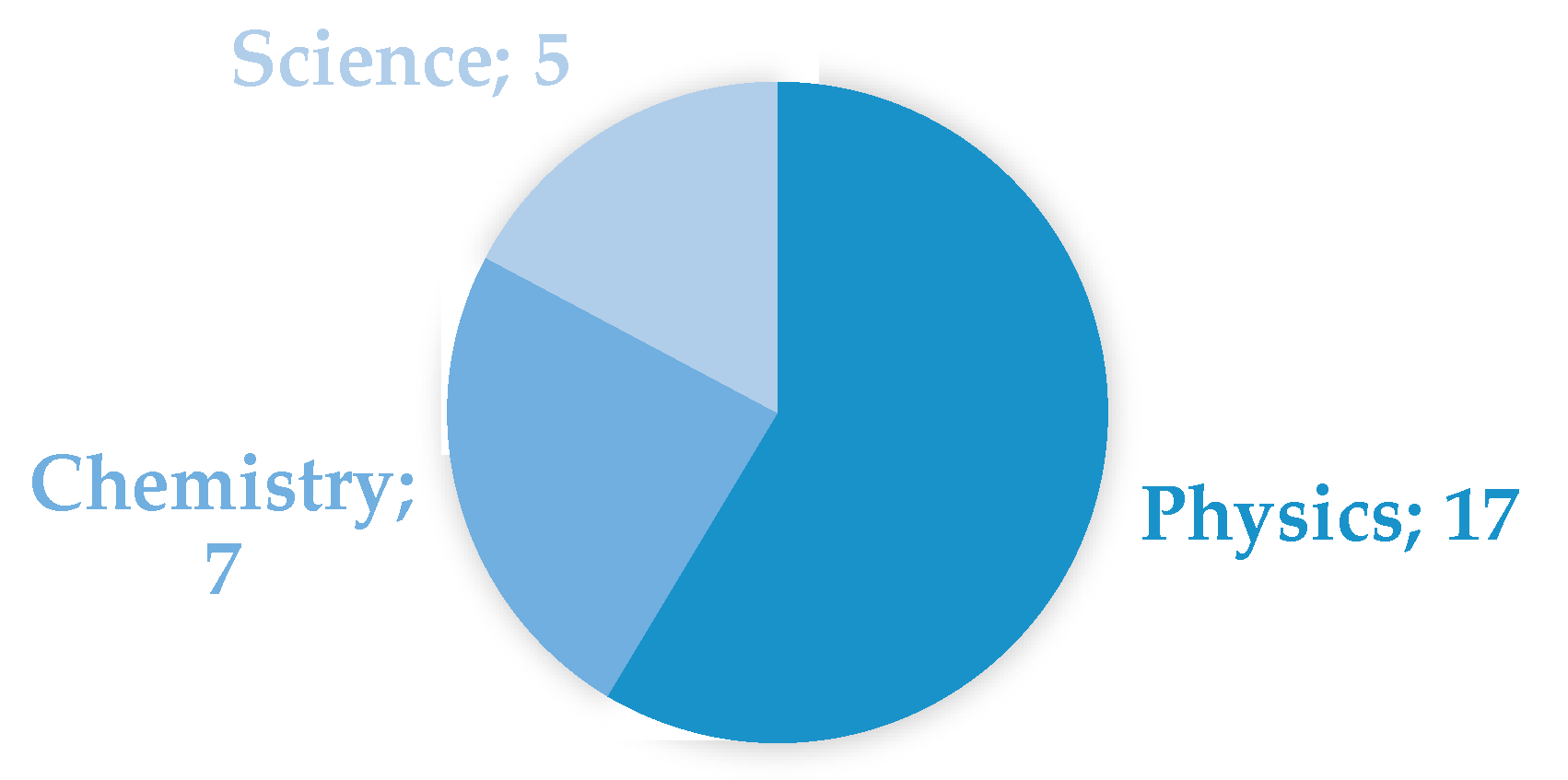
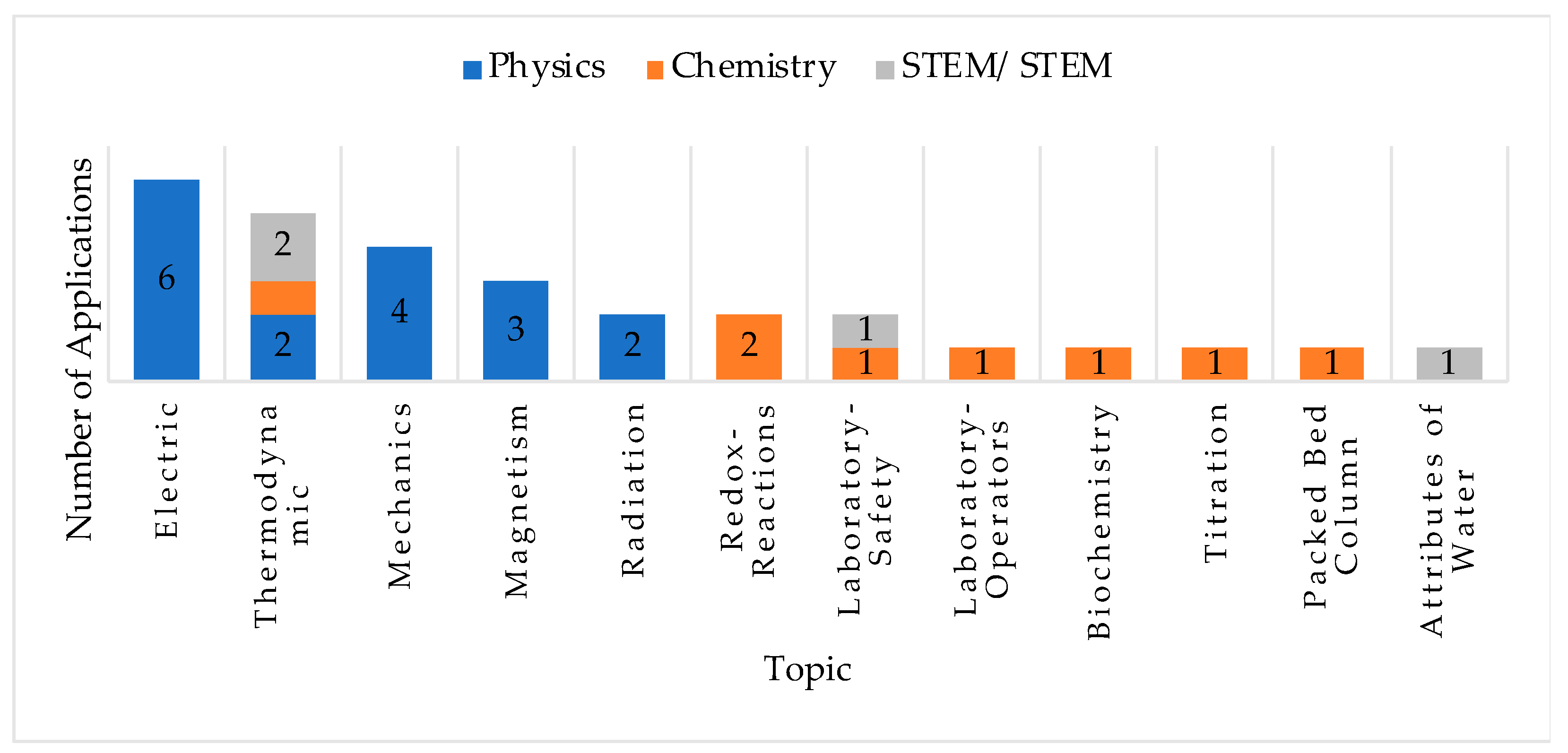
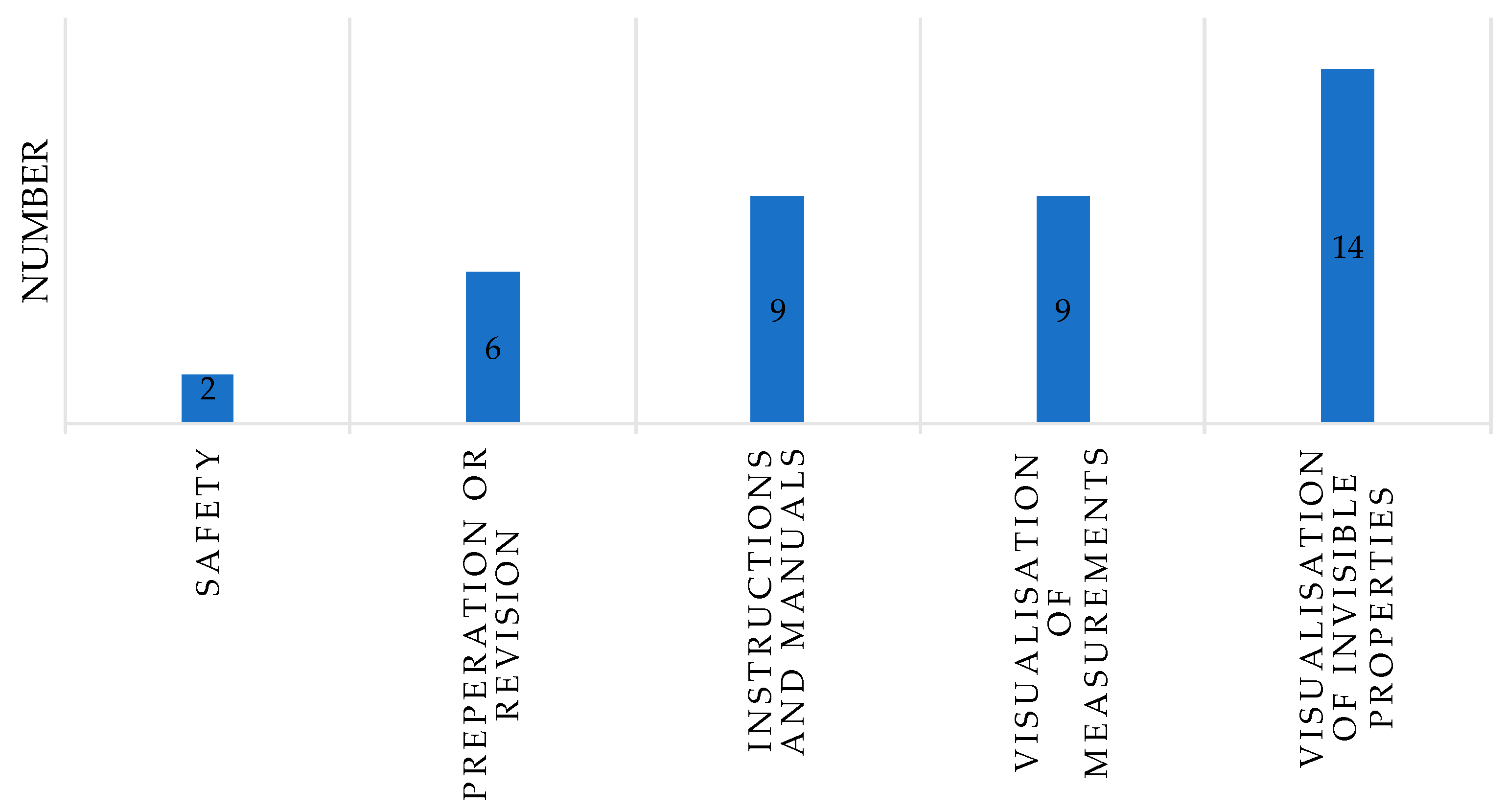
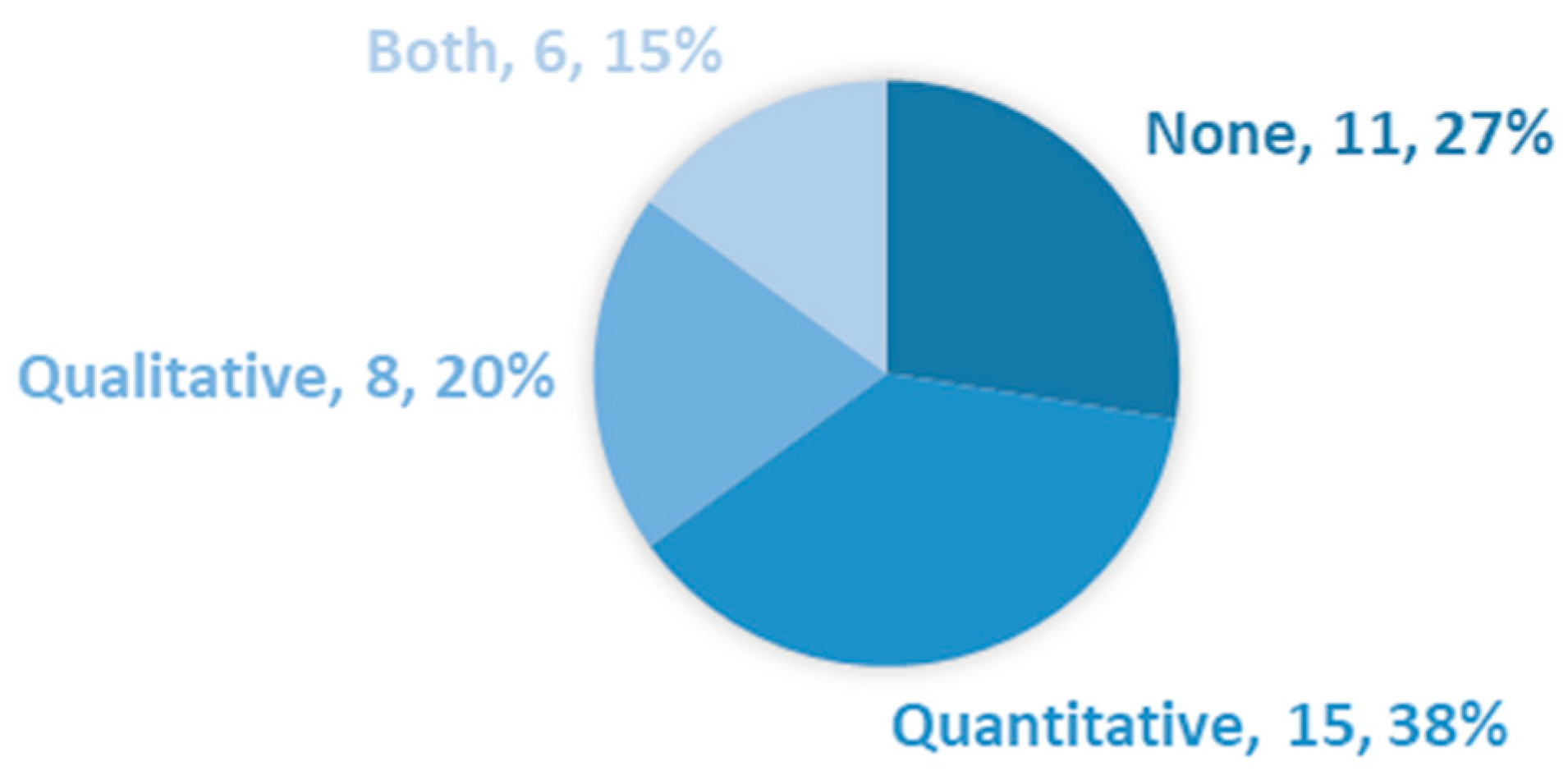
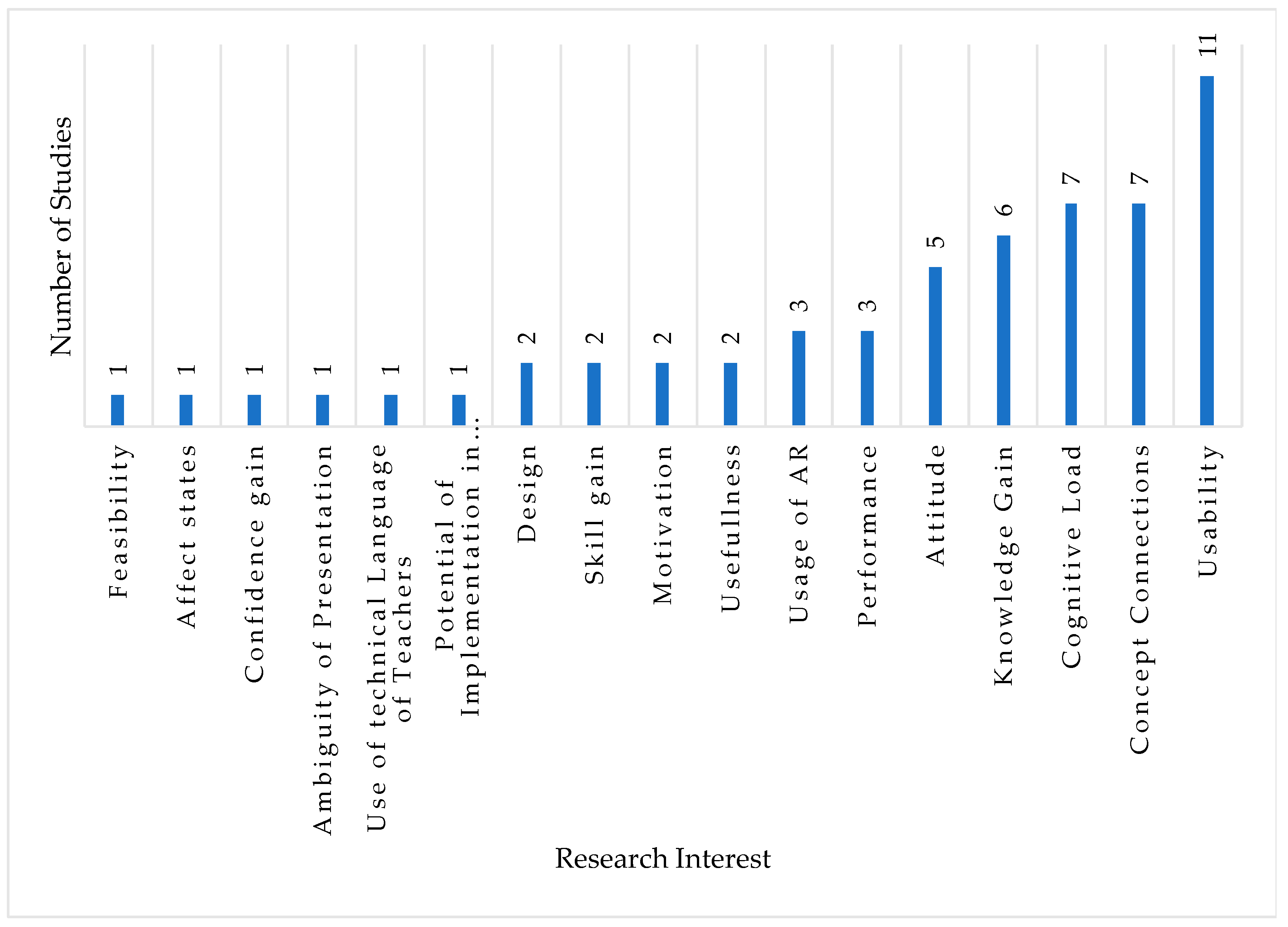

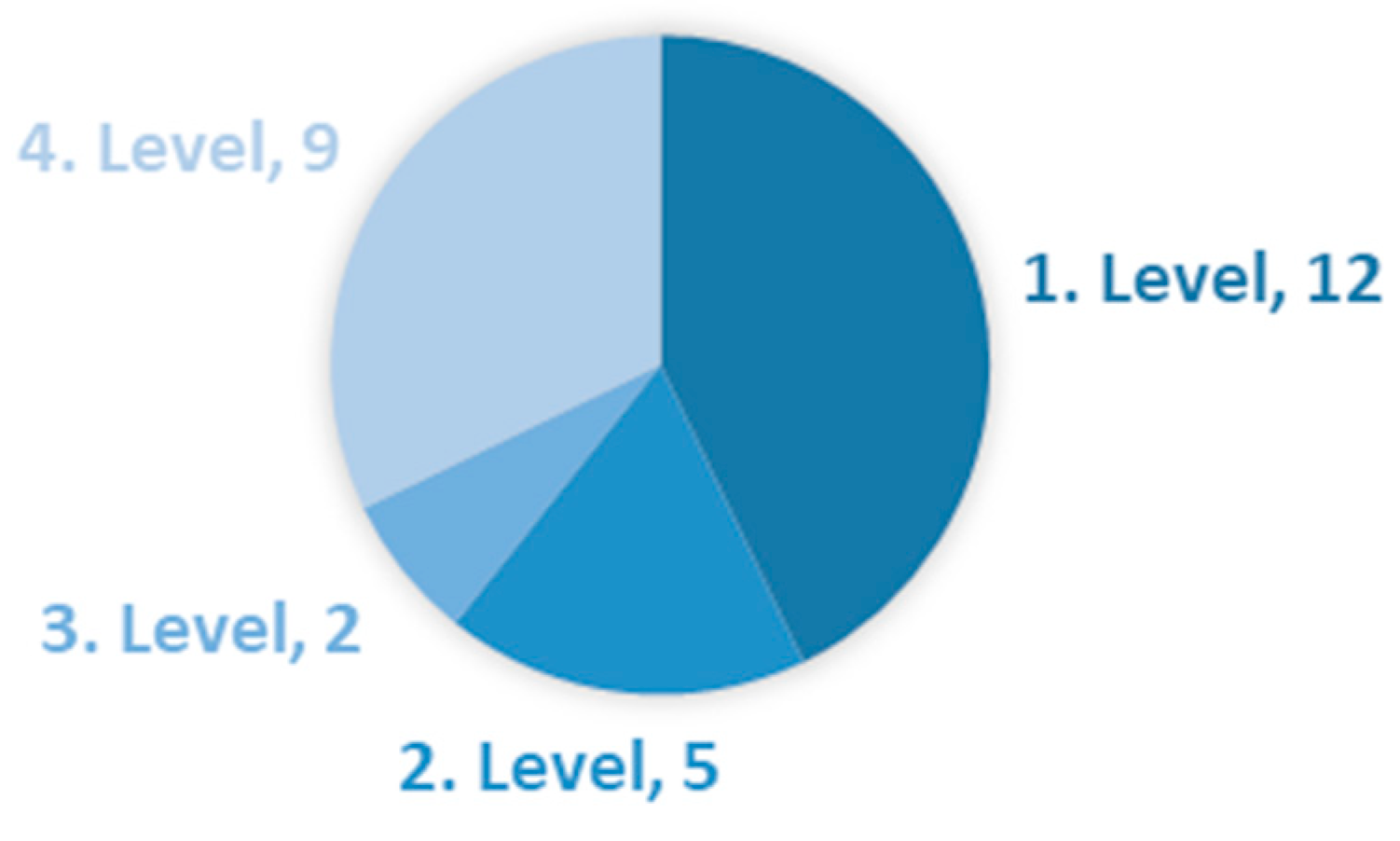
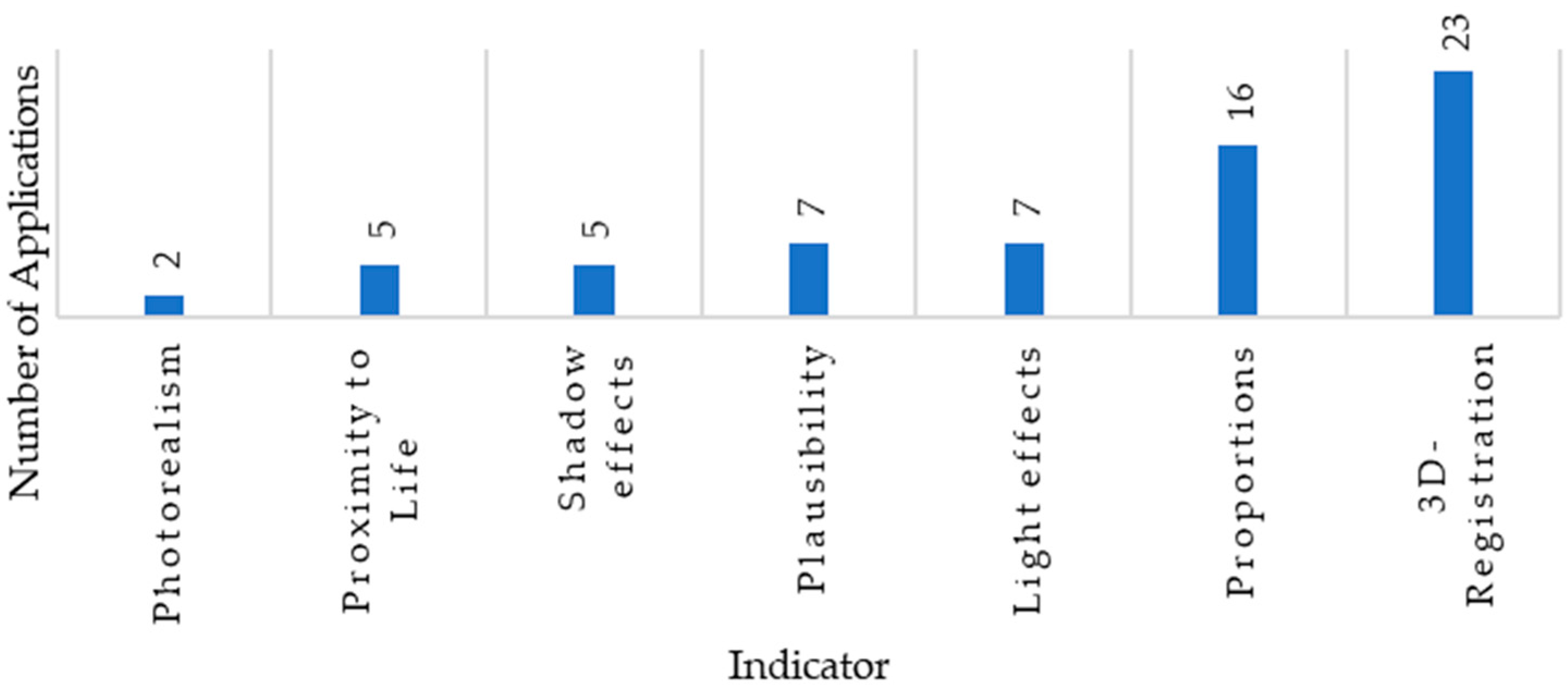

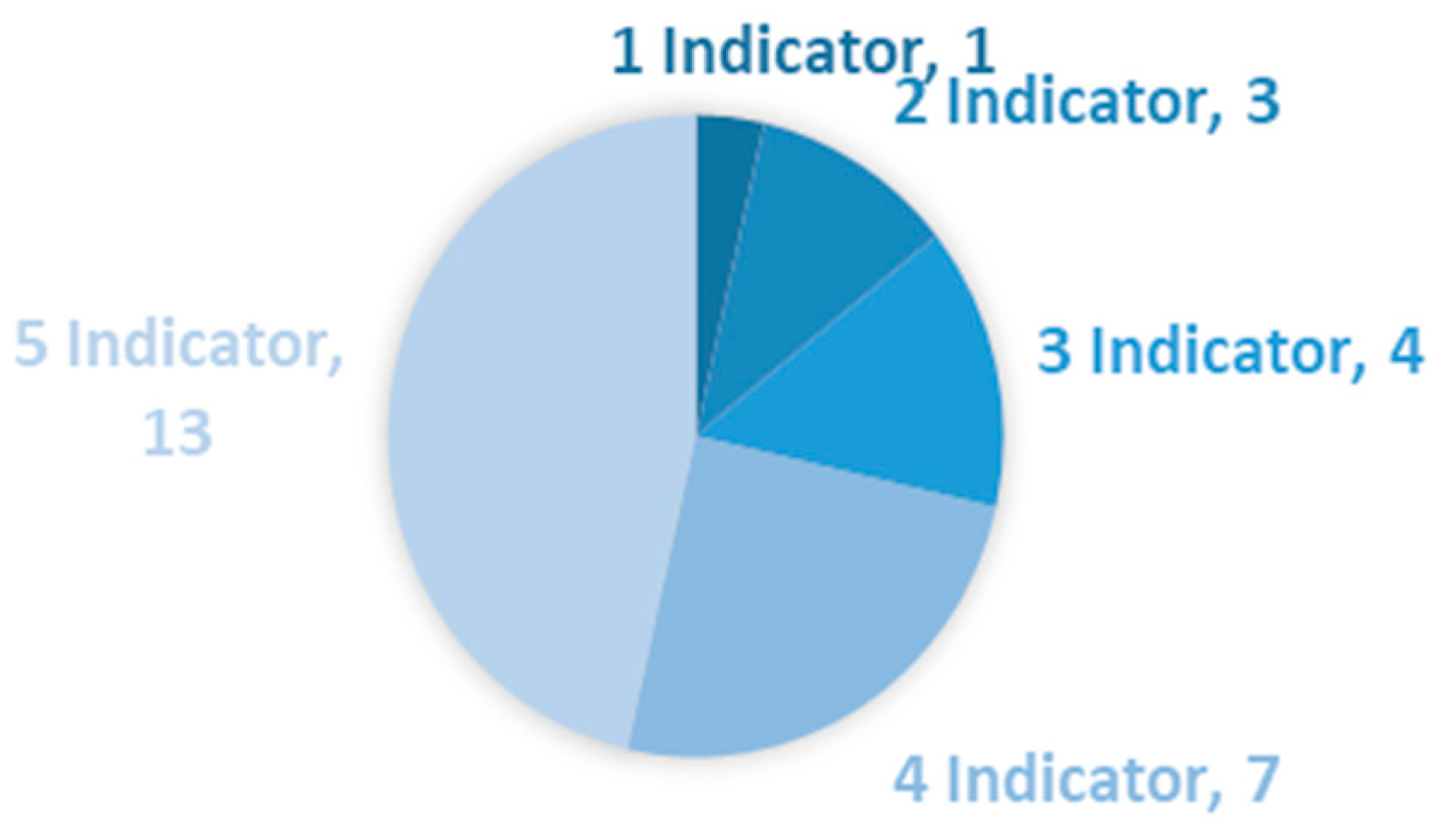
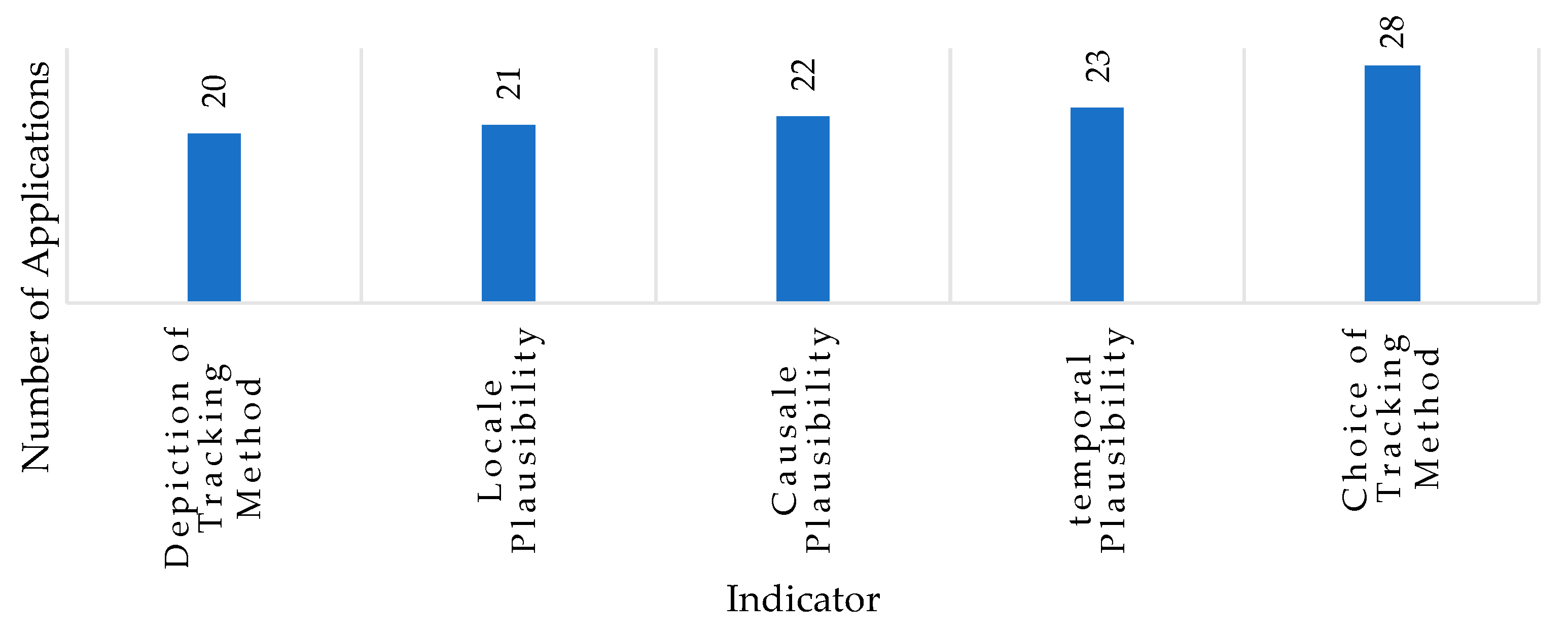
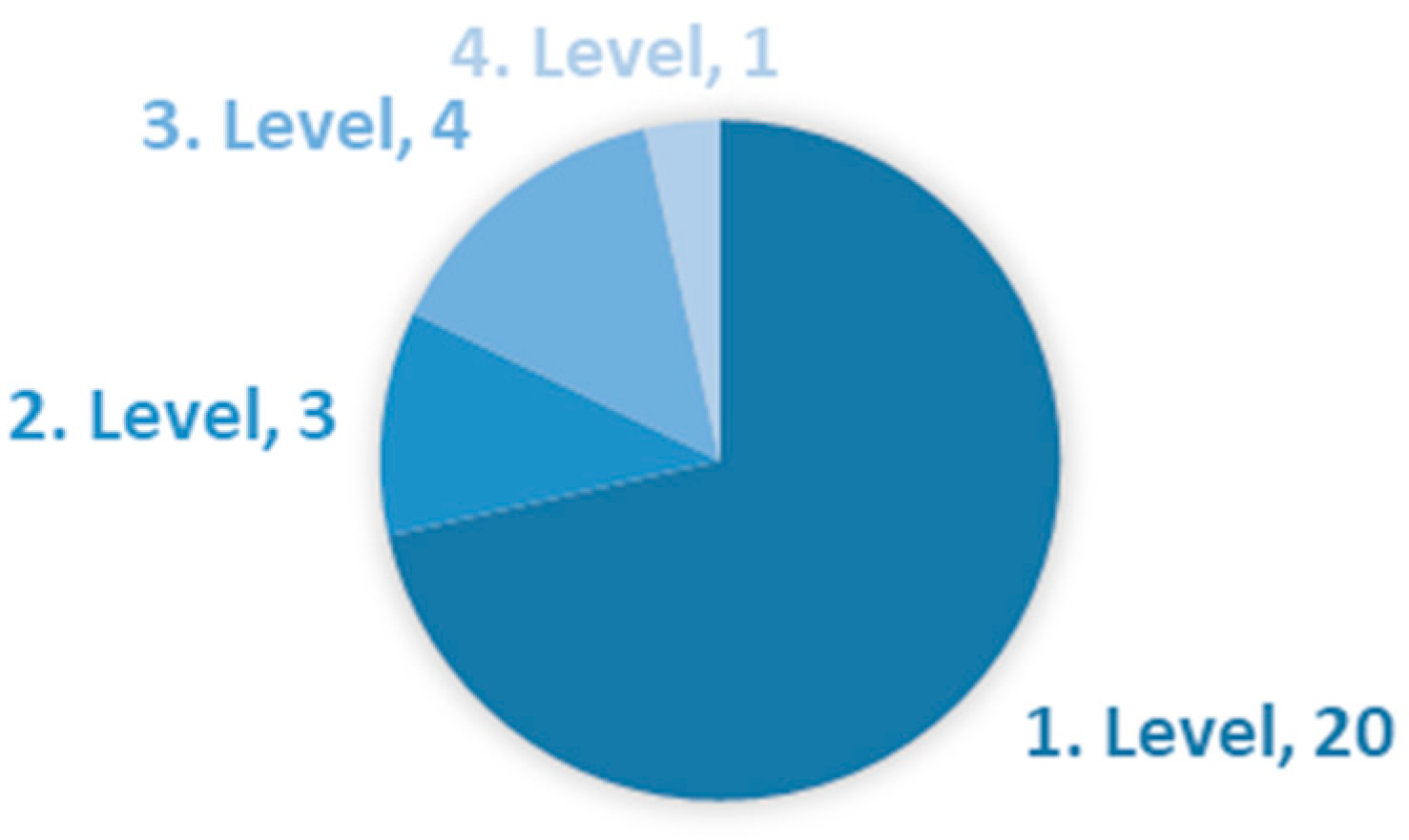
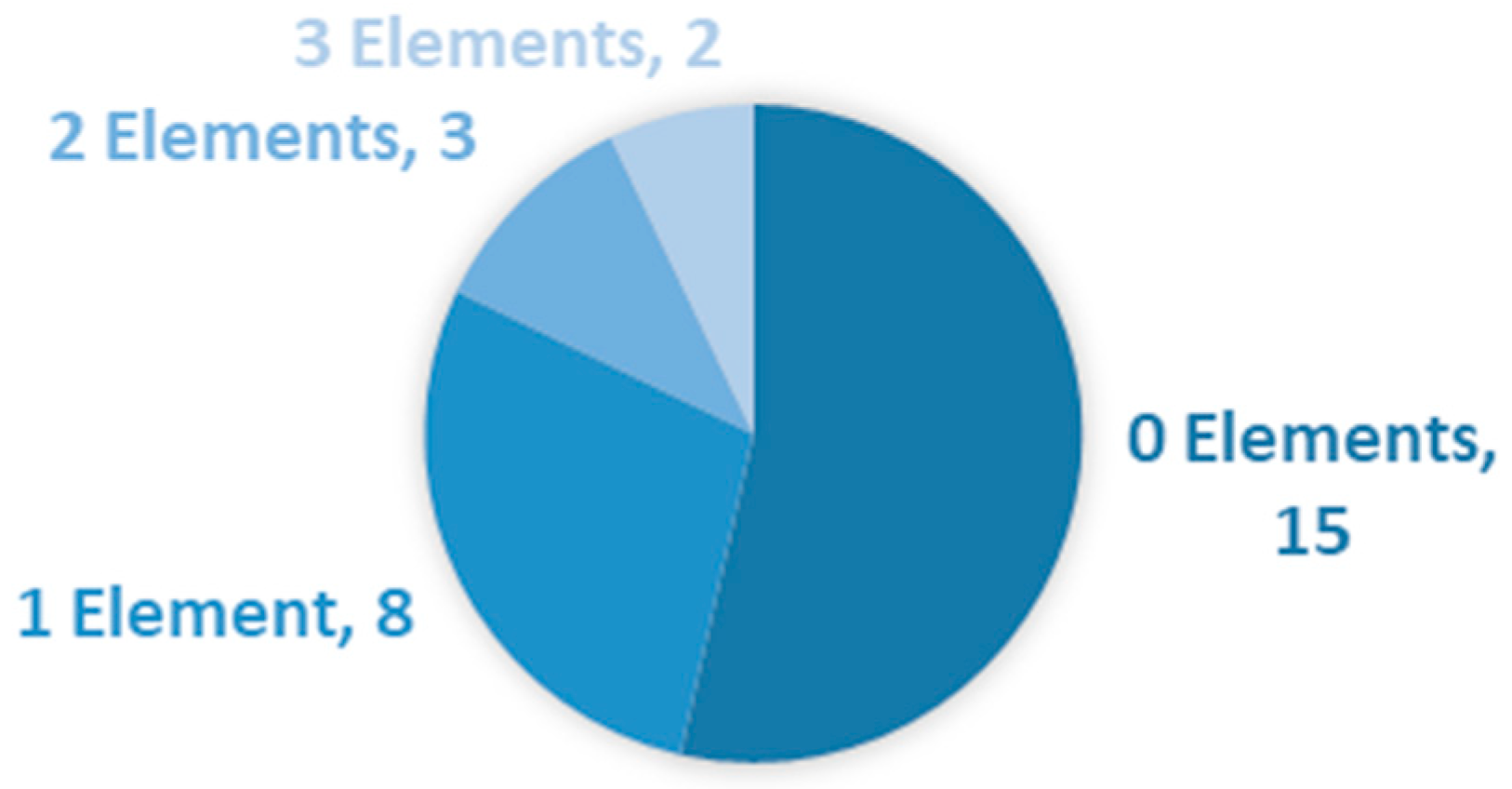


| Interest | Result | Number of Studies |
| Concept Connections | Higher | 5 |
| No difference | 2 | |
| Cognitive Load | No difference | 5 |
| Lower | 2 | |
| Knowledge Gain | Higher | 4 |
| No difference | 1 | |
| Attitude | Positive | 5 |
| Performance | Higher | 2 |
| No difference | 1 |
Disclaimer/Publisher’s Note: The statements, opinions and data contained in all publications are solely those of the individual author(s) and contributor(s) and not of MDPI and/or the editor(s). MDPI and/or the editor(s) disclaim responsibility for any injury to people or property resulting from any ideas, methods, instructions or products referred to in the content. |
© 2024 by the authors. Licensee MDPI, Basel, Switzerland. This article is an open access article distributed under the terms and conditions of the Creative Commons Attribution (CC BY) license (https://creativecommons.org/licenses/by/4.0/).
Share and Cite
Syskowski, S.; Wilfinger, S.; Huwer, J. Impact and Classification of Augmented Reality in Science Experiments in Teaching—A Review. Educ. Sci. 2024, 14, 760. https://doi.org/10.3390/educsci14070760
Syskowski S, Wilfinger S, Huwer J. Impact and Classification of Augmented Reality in Science Experiments in Teaching—A Review. Education Sciences. 2024; 14(7):760. https://doi.org/10.3390/educsci14070760
Chicago/Turabian StyleSyskowski, Sabrina, Sandra Wilfinger, and Johannes Huwer. 2024. "Impact and Classification of Augmented Reality in Science Experiments in Teaching—A Review" Education Sciences 14, no. 7: 760. https://doi.org/10.3390/educsci14070760
APA StyleSyskowski, S., Wilfinger, S., & Huwer, J. (2024). Impact and Classification of Augmented Reality in Science Experiments in Teaching—A Review. Education Sciences, 14(7), 760. https://doi.org/10.3390/educsci14070760










